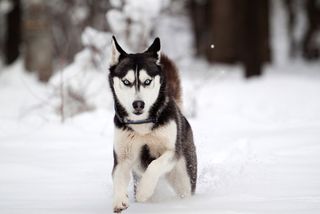Ancient Wolf DNA Could Solve Dog Origin Mystery

Humans and dogs were constant companions well before our ancestors settled in villages and started growing crops 10,000 years ago, a new study suggests.
Genetic evidence from an ancient wolf bone discovered lying on the tundra in Siberia's Taimyr Peninsula reveals that wolves and dogs split from their common ancestor at least 27,000 years ago. "Although separation isn't the same as domestication, this opens up the possibility that domestication occurred much earlier than we thought before," said lead study author Pontus Skoglund, who studies ancient DNA at Harvard Medical School and the Broad Institute in Massachusetts. Previously, scientists had pegged the wolf-dog split at no earlier than 16,000 years ago.
Although the prehistoric wolf went extinct, its genetic legacy lives on in Arctic sled dogs, the team discovered. "Siberian huskies have a portion of their genome that traces back exclusively to this ancient Siberian wolf," Skoglund told Live Science. "It's pretty amazing that there is a special genetic connection to a wolf that roamed the tundra 35,000 years ago."
Greenland dogs also carry some of this ancient wolf DNA, as do the Chinese Shar-Pei and the Finnish spitz, the study authors reported. The researchers plan to study what the genes do, as their role is not yet known, Skoglund said. [The 10 Most Popular Dog Breeds]
Mysterious ancestral wolf
Scientists once thought that dogs descended from gray wolves. Now, through genetic studies, researchers know that dogs and wolves share a common ancestor instead of a direct lineage.
Their common ancestor was a prehistoric wolf that lived in Europe or Asia anywhere between 9,000 to 34,000 years ago, according to various studies. (Several subgroups of prehistoric wolves went extinct about 10,000 years ago, at the same time as the mammoths, giant sloths and saber-toothed tigers.)
Sign up for the Live Science daily newsletter now
Get the world’s most fascinating discoveries delivered straight to your inbox.
Yet no one knows what kind of wolf gave rise to all of the amazing dog breeds living today. The Taimyr wolf won't solve the puzzle, as it also diverged from the wolf family tree about the same time that dogs and gray wolves split off, Skoglund said. However, the new Taimyr wolf genome does fine-tune the genetic timeline, called a molecular clock, which measures the rate of genetic mutations that build up through time.
Evolutionary clock
Skoglund and his colleagues sequenced both nuclear DNA and mitochondrial DNA (which moves only through the maternal line) from the 35,000-year-old rib bone. The team compared these ancient sequences with those from modern wolves and dogs.

Mutations in the Taimyr genome revealed the wolf evolutionary clock ticks more slowly than previously thought. A slower molecular clock pushes back the timing of the wolf-dog split. The revised molecular clock date is now more consistent with fossil evidence, said George Perry, an expert in ancient DNA at Pennsylvania State University, who was not involved in the study. Skull changes leading from wolf to dog start to appear about 33,000 years ago.
"It is a very well-done paper," Perry told Live Science. "This topic is a critical one for our understanding of human evolution and human-environment interactions in the Paleolithic. Partnership with early dogs may have facilitated more efficient hunting strategies."
If dogs first befriended hunter-gatherers, rather than farmers, then perhaps the animals helped with hunting or keeping other carnivores away. For instance, an author of a new book claims humans and dogs teamed up to drive Neanderthals to extinction. Skoglund also suggested the Siberian husky followed nomads across the Bering Land Bridge, picking up wolf DNA along the way.
"It might have been beneficial for them to absorb genes that were adapted to this high Arctic environment," Skoglund said.
This is the first wolf genome from the Pleistocene, and more ancient DNA from prehistoric fossils could provide further insights into the relationship between wolves, dogs and humans, the researchers said.
The results were published today (May 21) in the journal Current Biology.
Follow Becky Oskin @beckyoskin. Follow Live Science @livescience, Facebook & Google+. Originally published on Live Science.

